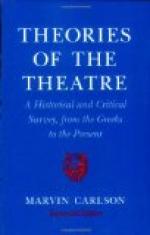For, nowadays at least, it is most essential that the drama should appeal to a crowd of women. Practically speaking, our matinee audiences are composed entirely of women, and our evening audiences are composed chiefly of women and the men that they have brought with them. Very few men go to the theatre unattached; and these few are not important enough, from the theoretic standpoint, to alter the psychologic aspect of the audience. And it is this that constitutes one of the most important differences between a modern theatre audience and other kinds of crowds.
The influence of this fact upon the dramatist is very potent. First of all, as I have said, it forces him to deal chiefly in action with passion for its motive. And this necessity accounts for the preponderance of female characters over male in the large majority of the greatest modern plays. Notice Nora Helmer, Mrs. Alving, Hedda Gabler; notice Magda and Camille; notice Mrs. Tanqueray, Mrs. Ebbsmith, Iris, and Letty,—to cite only a few examples. Furthermore, since women are by nature comparatively inattentive, the femininity of the modern theatre audience forces the dramatist to employ the elementary technical tricks of repetition and parallelism, in order to keep his play clear, though much of it be unattended to. Eugene Scribe, who knew the theatre, used to say that every important statement in the exposition of a play must be made at least three times. This, of course, is seldom necessary in a novel, where things may be said once for all.
The prevailing inattentiveness of a theatre audience at the present day is due also to the fact that it is peculiarly conscious of itself, apart from the play that it has come to see. Many people “go to the theatre,” as the phrase is, without caring much whether they see one play or another; what they want chiefly is to immerse themselves in a theatre audience. This is especially true, in New York, of the large percentage of people from out of town who “go to the theatre” merely as one phase of their metropolitan experience. It is true, also, of the many women in the boxes and the orchestra who go less to see than to be seen. It is one of the great difficulties of the dramatist that he must capture and enchain the attention of an audience thus composed. A man does not pick up a novel unless he cares to read it; but many people go to the theatre chiefly for the sense of being there. Certainly, therefore, the problem of the dramatist is, in this respect, more difficult than that of the novelist, for he must make his audience lose consciousness of itself in the consciousness of his play.
One of the most essential differences between a theatre audience and other kinds of crowds lies in the purpose for which it is convened. This purpose is always recreation. A theatre audience is therefore less serious than a church congregation or a political or social convention. It does not come to be edified or educated; it has no desire to be taught: what it wants is to have its emotions played upon. It seeks amusement—in the widest sense of the word—amusement through laughter, sympathy, terror, and tears. And it is amusement of this sort that the great dramatists have ever given it.




